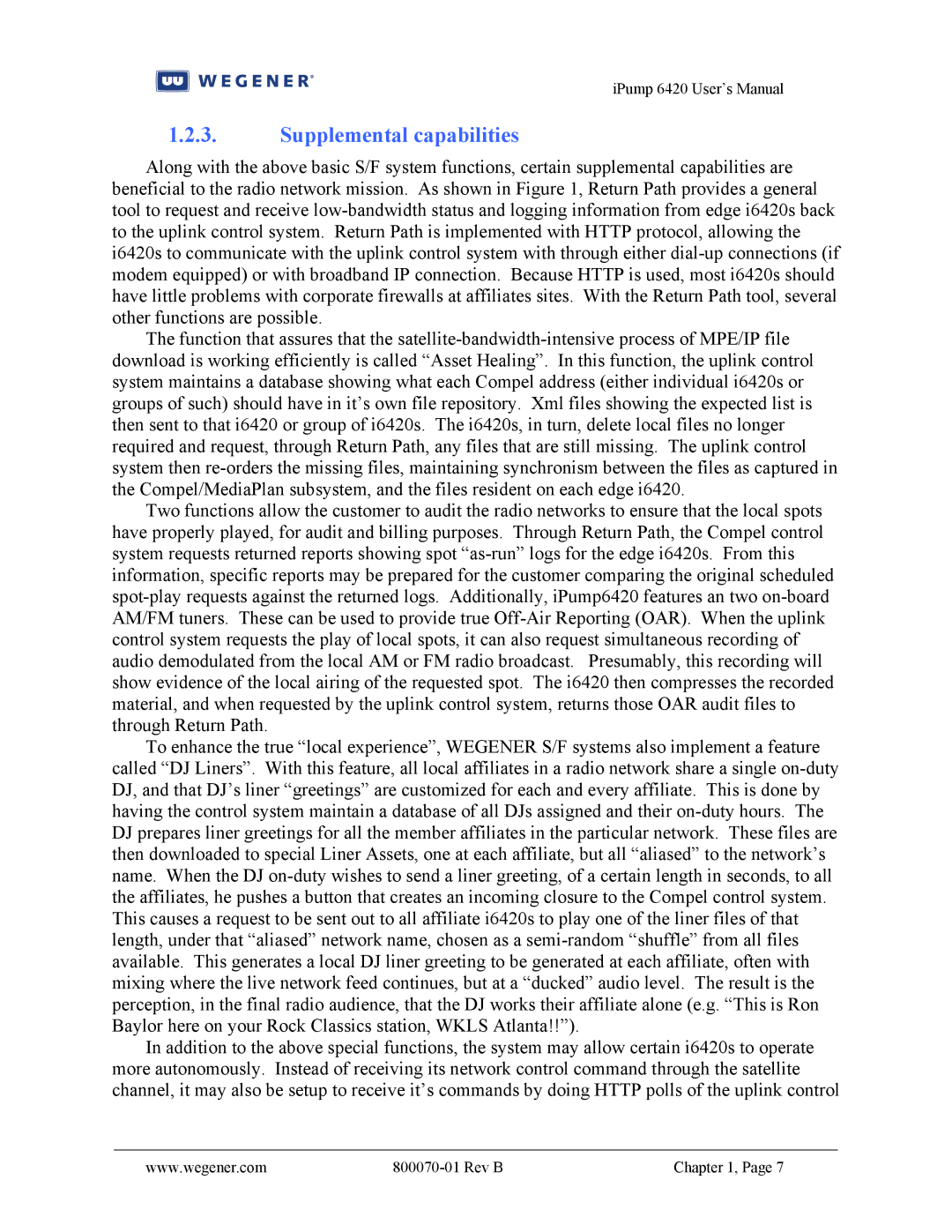iPump 6420 User’s Manual
1.2.3.Supplemental capabilities
Along with the above basic S/F system functions, certain supplemental capabilities are beneficial to the radio network mission. As shown in Figure 1, Return Path provides a general tool to request and receive low-bandwidth status and logging information from edge i6420s back to the uplink control system. Return Path is implemented with HTTP protocol, allowing the i6420s to communicate with the uplink control system with through either dial-up connections (if modem equipped) or with broadband IP connection. Because HTTP is used, most i6420s should have little problems with corporate firewalls at affiliates sites. With the Return Path tool, several other functions are possible.
The function that assures that the satellite-bandwidth-intensive process of MPE/IP file download is working efficiently is called “Asset Healing”. In this function, the uplink control system maintains a database showing what each Compel address (either individual i6420s or groups of such) should have in it’s own file repository. Xml files showing the expected list is then sent to that i6420 or group of i6420s. The i6420s, in turn, delete local files no longer required and request, through Return Path, any files that are still missing. The uplink control system then re-orders the missing files, maintaining synchronism between the files as captured in the Compel/MediaPlan subsystem, and the files resident on each edge i6420.
Two functions allow the customer to audit the radio networks to ensure that the local spots have properly played, for audit and billing purposes. Through Return Path, the Compel control system requests returned reports showing spot “as-run” logs for the edge i6420s. From this information, specific reports may be prepared for the customer comparing the original scheduled spot-play requests against the returned logs. Additionally, iPump6420 features an two on-board AM/FM tuners. These can be used to provide true Off-Air Reporting (OAR). When the uplink control system requests the play of local spots, it can also request simultaneous recording of audio demodulated from the local AM or FM radio broadcast. Presumably, this recording will show evidence of the local airing of the requested spot. The i6420 then compresses the recorded material, and when requested by the uplink control system, returns those OAR audit files to through Return Path.
To enhance the true “local experience”, WEGENER S/F systems also implement a feature called “DJ Liners”. With this feature, all local affiliates in a radio network share a single on-duty DJ, and that DJ’s liner “greetings” are customized for each and every affiliate. This is done by having the control system maintain a database of all DJs assigned and their on-duty hours. The DJ prepares liner greetings for all the member affiliates in the particular network. These files are then downloaded to special Liner Assets, one at each affiliate, but all “aliased” to the network’s name. When the DJ on-duty wishes to send a liner greeting, of a certain length in seconds, to all the affiliates, he pushes a button that creates an incoming closure to the Compel control system. This causes a request to be sent out to all affiliate i6420s to play one of the liner files of that length, under that “aliased” network name, chosen as a semi-random “shuffle” from all files available. This generates a local DJ liner greeting to be generated at each affiliate, often with mixing where the live network feed continues, but at a “ducked” audio level. The result is the perception, in the final radio audience, that the DJ works their affiliate alone (e.g. “This is Ron Baylor here on your Rock Classics station, WKLS Atlanta!!”).
In addition to the above special functions, the system may allow certain i6420s to operate more autonomously. Instead of receiving its network control command through the satellite channel, it may also be setup to receive it’s commands by doing HTTP polls of the uplink control
www.wegener.com | 800070-01 Rev B | Chapter 1, Page 7 |

